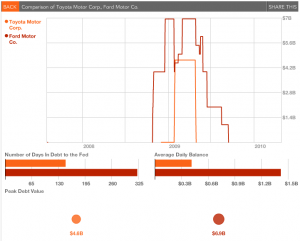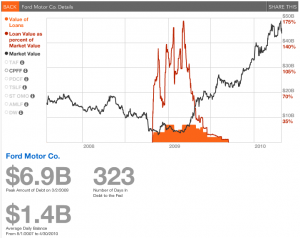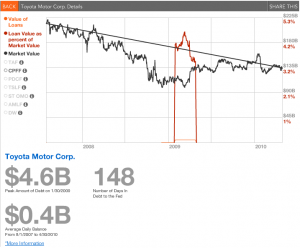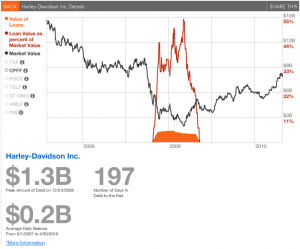The Other Auto Bailout: Ford, Toyota, … and Harley Davidson?
 As I noted yesterday, Bloomberg has made some really cool visual tools showing the lending the Fed did over the years.
As I noted yesterday, Bloomberg has made some really cool visual tools showing the lending the Fed did over the years.
So I wanted to use it to show the other auto bailout: lending to Ford and Toyota at a time when the auto market was fragile and credit was scarce.
Showing them side-by-side makes it clear that at the same time the government was discounting GM and Chrysler’s claim that unavailability of credit was a big part of their woes (and making them beg harder to get credit from the government), the Fed was providing credit to both Ford and Toyota.
Though you need to go further to see why the companies were taking the loans. The Ford image shows that it took the loans at a time when its market capitalization was in the toilet (remember its stock mirrored that of GM, and ostensibly to help GM out Ford participated in the testimony to Congress).So at the peak (and also around the time Chrysler was going into bankruptcy) the loans were worth almost 175% of Ford’s market value.
Note these loans were to Ford Credit: most likely, this reflects Ford relying on government loans to extend credit to its dealers to keep product moving.
Toyota’s loans, however, represented a much smaller percentage of its market value (which never fell as much as the others) and were significantly smaller than the loans Ford took out. But the loans also came during the period when Chrysler and GM were under the greatest stress.
 Not surprisingly, Toyota paid off these loans more quickly than Ford did, in 148 days as compared to 323.
Not surprisingly, Toyota paid off these loans more quickly than Ford did, in 148 days as compared to 323.
Ford and Toyota weren’t the only auto industry companies getting loans. BMW also had over $4B in loans, at times up to 27% of its value. There’s a $1.7B loan to Chrysler Financial (AKA Cerberus).
Perhaps the biggest surprise of all of this are Harley-Davidson’s $1.3B loans, at times over half its market value.
Now, I’m no expert on the motorcycle business. But like the auto business, it depends on moving product (both vehicles and parts) to independently operated dealers, which in turn rely on credit. So like the auto industry, the credit crunch resulting from the crash must have devastated it.
Add in the fact that, like GM, H-D ended up restructuring. It was also revamping its manufacture; it was also restructuring its labor agreements. It also had had profit woes which hit its stock price. Which made fall 2008 a shitty time to lose access to credit.
But unlike GM, it got Fed lending, which appears to have helped it weather the crisis.
Now, don’t get me wrong. In the long run, GM will be far better off having gone through its restructuring. But there was a time in 2008 when the folks in DC refused to believe that the auto business’ woes were, in significant part, credit-driven.
But it appears the Fed was well aware of that fact.


EW—Good work in identifying the Ford, Toyota, Harley-Davidson, and BMW borrowing from the Federal Reserve. The Bloomberg data also shows that Kenworth / Peterbilt trucks borrowed from the Fed, to the tune of $729M.
It strikes me that one of your Emptywheel timelines would be valuable here. There seem to have been two chronologies at issue: 1) the very public request by GM and Chrysler, and for a while, Ford, to get at $34B in TARP money from the Treasury, that started in November of 2008, after the election, and 2) the hidden Fed lending of about $16B to Ford, Toyota, BMW, et al, with the Fed authorizing such lending on October 28.
Bloomberg’s reporting shows Ford began borrowing the first day (Oct. 28) at about $4B and by December was up to the $6.9B peak. BMW and Kenworth/ Peterbilt also began borrowing on Day 1 from the Fed. Toyota did not start borrowing until February of 2009.
So I have two questions: why didn’t GM and GMAC and Chrysler Financial get to borrow on October 28 the way Ford did? Next question, did Ford’s access to Fed lending allow it to stay off TARP in December?
Wait, we knew about Harley at the time by my recollection.
EW–one other note about Ford. The 2008 annual report does not mention borrowing from the Fed, but the 2009 one does,
See p. 45 here: http://corporate.ford.com/doc/2009_annual_report.pdf Also, Ford Credit borrowed $1.1B from the European Central Bank in 2008 and another $1.8B in 2009.
Tata to Jaguar
re: Ford and 2008
Just for the record,a deal that began in 2007 culminated in Ford selling its Jaguar Land Rover to India’s Tata for 2.3 billion.
Here’s an excerpt from Ford PR:
FORD MOTOR COMPANY ANNOUNCES AGREEMENT TO SELL JAGUAR LAND ROVER TO TATA MOTORS
DEARBORN, Mich., March 26, 2008 – Ford Motor Company [NYSE: F] announced today that it has entered into a definitive agreement to sell its Jaguar Land Rover operations to Tata Motors. The transaction is the culmination of Ford’s decision last August to explore strategic options for the Jaguar Land Rover business transformation.
The sale is expected to close by the end of the next quarter and is subject to customary closing conditions, including receipt of applicable regulatory approvals.The total amount to be paid in cash by Tata Motors for Jaguar Land Rover upon closing will be approximately US $2.3 billion.
At closing, Ford will then contribute up to approximately US $600 million to the Jaguar Land Rover pension plans.
In addition, Ford Motor Credit Company will provide financing for Jaguar and Land Rover dealers and customers during a transitional period, which can vary by market, of up to 12 months.
The parties do not anticipate any significant changes to Jaguar Land Rover employees’ terms of employment on completion.
EW,
Great piece of industry analysis.
Thanks!
Bob in AZ
Making taxpayer resources available to individual citizens, who build neighborhoods and communities, schools and town halls, seems no longer to be government policy, since the political purpose of such money seems to have been forcibly narrowed to include only “assists directly in my re-election”.
Spending money on corporations is forceful, targeted, and potentially corrupting of both government and “private enterprise”, because the quid pro quos (re-election funds, legal and tax immunities) are so direct.
Spending it on individual citizens is like herding cats. No matter how much is spent, only a small portion of it will find its way back to a politician’s coffers or votes. The money would, however, more directly rebuild communities, neighborhoods and the economy instead of finding its way into the checkbooks of condo builders chosen by Haley Barbour.
The corruption of extending the kind of aid discussed in your article is self-reinforcing, in that the government asks nothing constructive back for it – firing of corrupt, high-risk executives and the hiring of better ones; more risk conscious and lower risk business practices, job creation and community reinvestment. The government only asks that its recipients duly reward the politicians who give it, both through election dollars and jobs for patronage networks.
As Warren Buffett says, this is a class war, and the billionaire millionaires aren’t winning it. Harsh language alone won’t reverse that course, even if the losers start realizing that’s what’s happening.
@earlofhuntingdon: “the billionaire millionaires ARE winning it.”